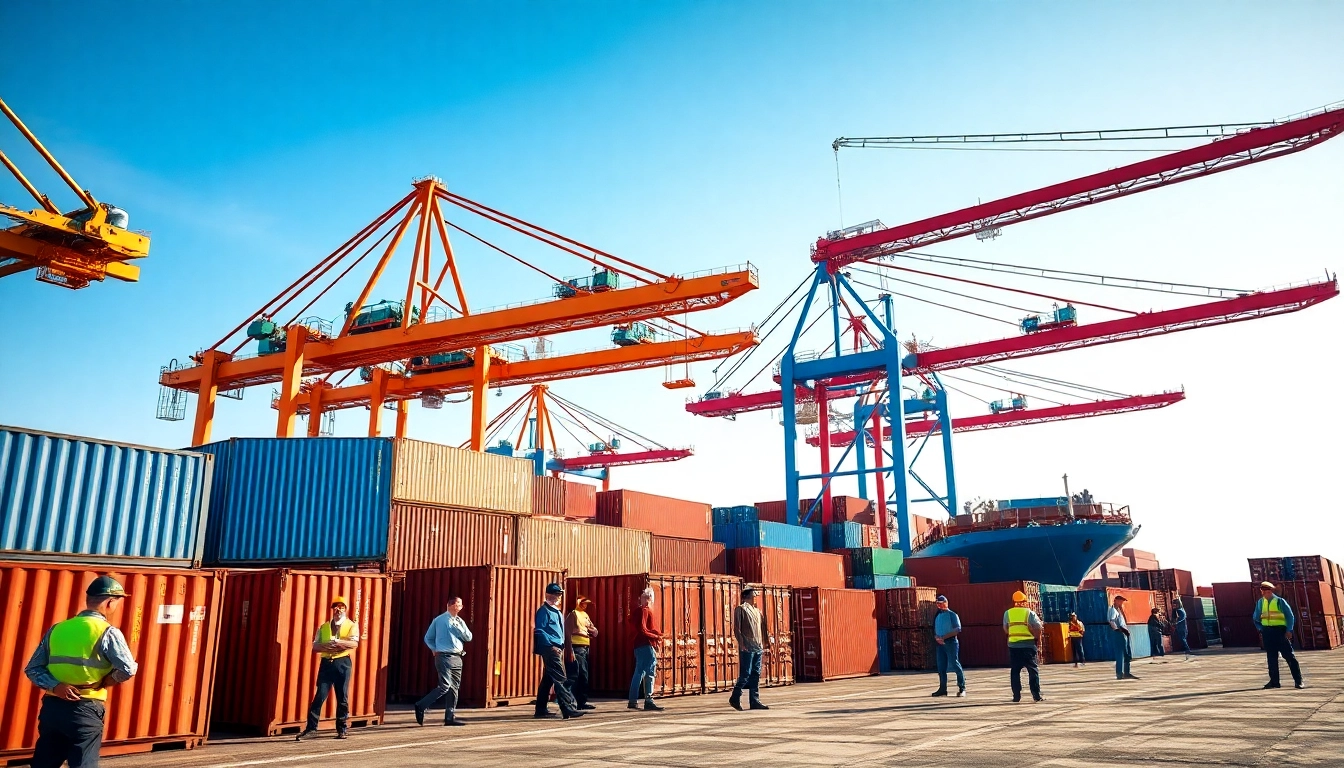What are Imports? Defining the Concept
The Basics of Imports: Definition and Importance
Imports play a crucial role in the global economy, representing the flow of goods and services into a country from abroad. More specifically, imports refer to products that are purchased by a resident of one country, but produced in another. This activity is a fundamental component of international trade, significantly impacting local markets, consumer choices, and the overall economy.
As one of the largest importers globally, the United States engages in diverse import activities that range from consumer electronics, automobiles, textiles, to raw materials. The significance of imports extends beyond mere consumption, contributing to greater economic interconnectedness and supply chain efficiency. Understanding the intricacies of imports is essential for businesses and individuals alike, especially in today’s globalized market. To gain further insights, it’s worth exploring resources discussing imports and their impact.
Historical Context: The Evolution of Imports in Trade
The concept of imports has evolved significantly over the centuries. In ancient economies, trade typically occurred through barter systems where people exchanged goods directly. With the advent of currency and more sophisticated trade routes, the importation of foreign goods surged.
During the Age of Exploration in the 15th and 16th centuries, European nations expanded their trade networks, leading to a surge in imports from the Americas, Asia, and Africa. The Industrial Revolution further accelerated this process, as mass production in industrialized countries increased the availability of consumer goods, necessitating greater imports to satisfy local demands. By the late 20th century, the rise of globalization led to unprecedented levels of imports and exports, reshaping economies worldwide.
Key Players in the Import Process: Who is Involved?
The import process involves a variety of stakeholders, each contributing to the complexity of international trade. Key players include:
- Importers: Businesses or individuals that purchase goods from foreign suppliers.
- Exporters: Producers in foreign countries that sell goods to importers.
- Customs Authorities: Government agencies that regulate and facilitate the movement of goods across borders, ensuring compliance with relevant laws.
- Freight Forwarders: Logistics experts managing the transportation of goods from the exporter to the importer.
- Trade Associations: Organizations that represent the interests of businesses engaged in importation, providing advocacy and information.
- Consumers: The final users of imported goods, whose demand drives the import market.
Types of Imports: A Breakdown
Consumer Goods: Major Categories in US Imports
Consumer goods are one of the largest segments of imports in the United States. These products directly affect the day-to-day lives of American consumers. Major categories of consumer goods include:
- Electronics: Including smartphones, computers, and home appliances.
- Clothing and Footwear: Apparel items imported from various countries, particularly from Asia.
- Automobiles: Cars and parts from countries like Japan and Germany.
- Food and Beverages: Including specialty foods and beverages from across the globe.
The trend of consumer imports reflects changing preferences and demands, as well as competitive pricing strategies from foreign manufacturers.
Capital Goods and Their Impact on Trade
Capital goods, which include machinery, tools, and equipment used in the production of goods and services, form another essential category of imports. These goods have significant implications for domestic industry capacity and productivity.
By importing advanced capital goods, businesses can enhance their manufacturing capabilities, adopt new technologies, and reduce production costs. For example, U.S. manufacturers often import sophisticated machinery from countries known for their engineering advancements, improving output quality while maintaining lower pricing on finished goods.
Raw Materials: The Backbone of Imports
Raw materials are fundamental to various industries and constitute a considerable portion of U.S. imports. These materials serve as the inputs required for manufacturing processes. Key categories of raw materials include:
- Metals: Such as steel and aluminum, critical for construction and manufacturing.
- Plastics and Chemicals: Used in a plethora of industries from packaging to pharmaceuticals.
- Agricultural Products: Including grains, fruits, and livestock, which often cannot be produced domestically in sufficient quantities.
By ensuring a steady supply of raw materials through imports, U.S. industries can maintain production levels and meet consumer demand effectively.
Understanding Import Regulations
Customs and Duties: What to Know
The process of importing goods is governed by a myriad of regulations, primarily to ensure compliance with national laws and international agreements. Customs duties, which are taxes imposed on imported goods, represent a significant consideration for businesses importing products.
Different products are subject to varied tariffs, which can change based on geopolitical situations, trade agreements, and domestic economic policies. Importers must be well-versed in identifying the applicable duties for their products to manage their costs effectively.
Compliance: Ensuring Legal Import Practices
Adhering to import regulations is crucial for avoiding penalties and ensuring smooth operations. Compliance encompasses understanding and following all legal requirements such as:
- Accurate classification of products for tariff purposes.
- Proper documentation for shipments, including invoices, bills of lading, and certificates of origin.
- Adhering to safety and quality standards mandated by U.S. regulations.
Failure to comply can result in costly fines, shipments being detained, or goods being returned to the sender, emphasizing the need for thorough knowledge of import laws.
Trade Agreements and Their Influence on Imports
Trade agreements are vital in shaping import dynamics as they govern the terms of trade between countries. Agreements like NAFTA (now USMCA) and the EU trade arrangements have facilitated smoother and more cost-effective trading conditions. Such agreements can:
- Reduce or eliminate tariffs on specific goods.
- Ensure higher standards of product quality and safety.
- Pave the way for collaborative trade practices amongst member countries.
As the political landscape evolves, so too can trade agreements, necessitating active monitoring of changes that could affect import costs and practices.
Challenges and Considerations in Imports
Identifying Common Import Issues
The import process is fraught with challenges ranging from logistical hurdles to regulatory compliance. Common issues include:
- Supply Chain Disruptions: Events such as natural disasters or global pandemics can adversely affect the smooth flow of goods.
- Fluctuating Tariffs: Changes in trade policies can impact the cost benefits of importing specific goods.
- Quality Control Issues: Imported goods may not always meet domestic quality standards, leading to potential safety concerns.
Recognizing these challenges is essential for businesses looking to mitigate risks associated with international trade.
Strategies for Mitigating Import Risks
To effectively navigate the complexities of importing, businesses can employ various strategies:
- Diversification of Suppliers: By sourcing from multiple suppliers across different countries, businesses can reduce their risk of disruptions.
- In-depth Market Research: Understanding market trends, tariffs, and competitor strategies can provide a competitive edge.
- Regular Compliance Audits: Conducting audits helps ensure adherence to regulations and mitigates the risk of penalties.
Implementing these strategies not only protects the business but also promotes operational efficiency.
Future Trends: Navigating Changes in the Import Landscape
The future of imports is likely to be shaped by several trends, influenced by technological advancements and shifting geopolitical relations. Key trends include:
- Increased Automation: The adoption of advanced technologies such as AI and robotics in logistics could streamline the importing process.
- Sustainability Considerations: Growing consumer awareness regarding environmental issues may drive demand for sustainably sourced products and ethical import practices.
- Geopolitical Shifts: Changing trade relations between countries may lead to new trade patterns and altering tariff landscapes.
Businesses must remain agile and adaptable to capitalize on emerging trends while mitigating associated risks.
The Economic Impact of Imports
Imports vs Exports: Balancing the Trade Scale
The interplay between imports and exports plays a critical role in determining a nation’s trade balance. A country like the United States, which has a trade deficit (where imports exceed exports), faces unique economic implications:
- A persistent trade deficit can lead to currency depreciation, affecting purchasing power.
- Increased imports may benefit consumers through lower prices and variety, but extended reliance can hinder domestic production.
- Conversely, a balanced trade scenario can stimulate local economies while supporting international partnerships.
Understanding these dynamics is crucial for policymakers aiming to promote a healthy economy.
Import Data: Analyzing Economic Indicators
Import data serves as a valuable economic indicator, providing insights into consumer demand and market trends. Analyzing continuous statistics on imports can yield key information such as:
- Consumer spending patterns and demand forecasting.
- Sector-specific performance insights that can guide investment and production decisions.
- Trade relationship insights that influence diplomatic and economic policies.
With the increasing availability of data analytics tools, businesses can leverage import data for strategic decision-making.
Consumer Impact: How Imports Shape Markets
The influx of imported goods profoundly shapes consumer markets. Importation empowers consumers with greater choice and access to various products globally. For instance:
- Consumers benefit from competitive pricing, as imported goods often come at lower prices due to reduced production costs abroad.
- Innovation and quality improvements, as imported products may introduce new features and advanced technologies not available locally.
- However, reliance on imports can have mixed effects, including potential job losses in domestic industries that cannot compete with cheaper foreign goods.
A comprehensive understanding of how imports shape consumer preferences contributes to more informed purchasing and policy decisions.



